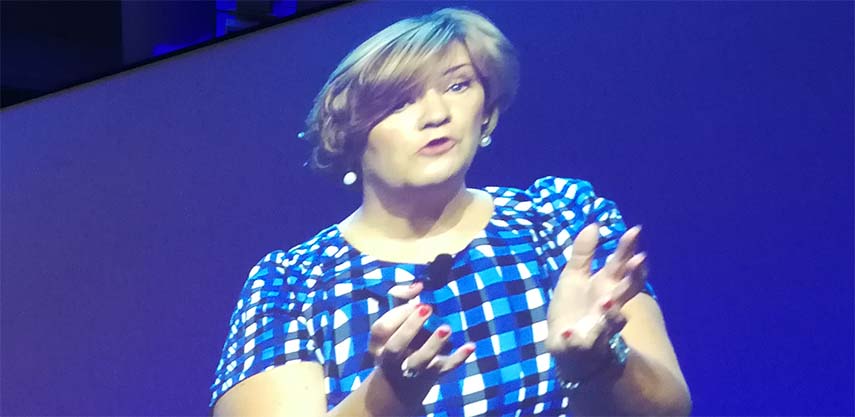Kathy Gibson is at SAP SuccessConnect in Berlin – People technology is at the centre of human resources (HR) today – and HR is increasingly recognised as a crucial driver of the business overall.
This is the word from Greg Tombs, president of SAP SuccessFactors, who says the individual user experience is key to providing total workforce management in the intelligent enterprise.
“We mix technology with our personal lives all the time – and we have to bring this into the workplace,” Tombs says.
Talent is keeping CEOs awake at night, and is now the top concern, according to PwC.
“Talent can be a roadblock. Or – if you attack it – it can be a catalyst for success,” Tomb says. “It’s about agility and speed, and making sure you have the right talent.”
Attracting and retaining talent includes things like health and well-being, he adds. “There is a direct correlation between each individual, how they are mentally and physically when they come to the workplace, and how they are able to perform.
“So we have to figure out how to help employee’s address their health and well-being.”
This ties into total workforce management, where HR has to consider the spectrum of workers, including gig workers, intrapreneurs, contractors and employees.
“How do we bring that all together so we have total workforce planning, workforce design?” Tomb asks. “Two-thirds of your workforce are not employees. But you need a consistent view of all of them.”
The intelligent enterprise is based on using multiple applications to build a next-generation of business process, he adds
In the near future, we won’t be able to rely on just the skills on their resume to find job candidates.
We will need to know about their personality, how they would fit into the team, even their current emotional profile. A lot of this will be enabled by data analytics.
But this doesn’t mean that machines or technology will overtake or replace people – rather they will be used to enhance them, says Kristen Cousins, solution engineer at SAP.
Adaire Fox-Martin, executive board member at SAP, responsible for global customer operations, beieves there needs to be a focus on the “wholeness” of employees.
“No-one comes to work just as a worker,” she points out. “When we look at our private lives, we can see that people are exceptionally demanding. In fact, just one out of six of us will complain if we have a negative online experience – the others will just leave.
“So when we arrive at work, we arrive as savvy, sophisticated users. The lines between personal and work lives are blurring. So if there is a negative experience at work, employees are less likely to be an ambassador or vacate for our company.”
In today’s economy, every company is going to be a software company – and software is ultimately developed by people and for people, Fox-Martin adds.
SAP has built a strategy to help organisations unlock value, Fox-Martin says.
This starts with the business, is supported by the HR function, and underlined by the employees.
“There is no doubt that every company we speak to has gone beyond the stage of awareness when it comes to digital and digital transformation,” she adds. “Most are trying to change now, while they can rather than later when they have to.
“Most companies are having to deal with the pace of change,” she explains. “The pace of change is like something we have ever experienced before – and it is not going to get any slower.”
Technologies – cloud and mobile – are creating data at a volume that is almost impossible for business to unlock their value. “How do you cash in on the value of this data?” Fox-Martin asks.
Companies are having to reimagine business models to service customers in new ways; all while being more effective and at the same time engaging differently with employees.
“This boils down to how do I make money; how do I save money; and how do I do this with efficient and engaged employees,” Fox-Martin explains.
“SAP has a duty of care to help companies navigate this journey from a variety of starting points, she says.
“We help them become intelligent enterprises through the provision of an intelligent suite of applications built on data and that integrates across the company. Each step fuels intelligence, refining process so you can put the innovation engine to work.
“This helps us to remove silos and bring customers the intelligence they require across the SAP portfolio.”
She cites an example of how, when an employee like a manager leaves, there are implications way beyond just HR and into the business.
“As HR leaders we are looking for agile, attractive and sustainable outcomes that help to support not just he HR functions – but supplement them with financial and analytical data.”
The HR organisation of the future is a company where 40% of the total workforce will be contingent; but where the total workforce needs to be managed consistently across all the processes.
“By combining S4/HANA, SAP SuccessFactors and SAP Fieldglass, we are able to offer a mega-process with all the data sets that allow companies to effectively manage either workforce.”
These are supported by unified analytics, master data and a unified user experience, she adds.
Analytics combined with insights helps to make not just good decision, but the right decision. Companies can combine data from the fulltime and contingent workforce to understand the HR and business implications of any decisions.
“This lets employees work as they live, in an intuitive environment, with processes all personalised. This means employees can be productive and, more importantly, happy.”
SuccessFactors has 6 500 global customers and 100-million users, processing 1-billion daily transactions – inn fact it is the biggest cloud-based application service in the world. Its product portfolio includes attract, talent, learning and payroll applications.

